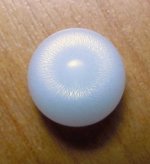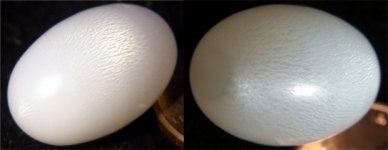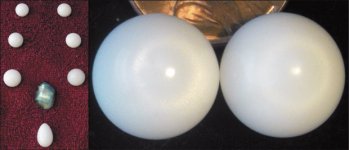You are using an out of date browser. It may not display this or other websites correctly.
You should upgrade or use an alternative browser.
You should upgrade or use an alternative browser.
KIMA (Tridacna sp) Pearls
- Thread starter SteveM
- Start date
Hanaleimom
Member
Last night, I could see pic in post #9 at home. Today, it's red X at work. It must be my office PC.
lisa c
Perpetual Pearl Student
I can not see the picture in post #9 only a red X, but the picture in post #1 is ok.
The same for me.
GemGeek
Pearlista
It's beautiful, Anna, and will show beautifully in a ring--love the pink gold idea!
Yes - what she said!!!
GemGeek
Pearlista
I can not see the picture in post #9 only a red X, but the picture in post #1 is ok.
Me too. We need to figure this out. Maybe Steve should try posting it with a one-word name for another test?
CLICLASP
Well-known member
Thanks and thanks to the forum that brought me the idea of that type of pearl and educated me ...
Caitlin
Well-known member
Trying saving your photos as jpegs before posting. That format is recognized by just about all computers.
Hi Anna
I can hardly wait to see what you do with that. You and Steve seem to pioneering kimas as jewelry (love that name!)- or at least the first I've seen!
Hi Anna
I can hardly wait to see what you do with that. You and Steve seem to pioneering kimas as jewelry (love that name!)- or at least the first I've seen!
Last edited:
Pearly Shell
New Member
So many beautiful examples!
A quick question: How rare are Kima pearls? As rare as Conch or Melo Melo? Less? What kind of value is placed on Kima pearls?
A quick question: How rare are Kima pearls? As rare as Conch or Melo Melo? Less? What kind of value is placed on Kima pearls?
Only Natural Pearls
New Member
From a dealer's perspective, I completely agree that 'Tridacna' is a less than attractive appellation for what is indeed a truly beautiful pearl. Other natural pearls such as the enchanting 'Melo' have names which hint at the true romance inherent in these stunning pearls, but 'Tridacna' sounds way too technical and indeed plain cold. Some stunning gemstones have suffered from a similar fate : spinel, for example, can be an absolutely breathtaking stone, but has been, and continues to this day to be hampered by its unattractive name.
In short, a re-branding of Tridacna makes sound commercial sense, and I will start to market some of my Tridacna stock on my website as Kima Pearls (tridacna species). Needless to say, I will follow this thread with great interest !
http://www.trocadero.com/OnlyNaturalPearls/
In short, a re-branding of Tridacna makes sound commercial sense, and I will start to market some of my Tridacna stock on my website as Kima Pearls (tridacna species). Needless to say, I will follow this thread with great interest !
http://www.trocadero.com/OnlyNaturalPearls/
Attachments
SteveM
Well-known member
- Joined
- Jan 29, 2007
- Messages
- 2,113
Final reposting for the photo in Post 9 is done (no punctuation in the name). Let me know…
Only Natural: Appreciate the solidarity. Kima represents a fresh start for this gem, more consistent with its peers and with its quality. Sometimes the most sensible ideas are also the most obvious!
I would maintain 'Tridacna' for non-gem-quality, such as Pearl of Allah (in large and small versions) or plain-surfaced specimens that require lab analysis to differentiate from carved shell.
Regarding rarity, that goes hand in hand with demand, which at this point is spotty for this species. But the best quality, such as Only Natural's specimen above, has a steady if not ultra-high-profile clientele. Pricing at source is comparable with a wide range of naturals (per carat or per gram), to this point without a lot of differentiation per quality. That represents some opportunities for the savvy buyer.
Hubert Bari in Pearls and a popular EBay seller testify to the rarity, but do not manage to show top quality. These would not be an example of Kima to my thinking, although certainly they are Tridacna. Pricing at the EBay seller is also extremely low, but perhaps appropriate for the quality.
Another aspect of Tridacna is its occasional stand-in status for two of pearldom's most mythical pearls: Coconut and Nautilus. In the former case, pearls of plain white surface such as the one linked in the previous paragraph are proposed as calcified vegetal concretions, "mustika" objects fetching astronomical prices in the Indo-Pacific area. In the latter case, which we now propose as Kima with flame and chatoyant halo, 'carefully documented' examples have been traded commercially and/or certified as Nautilus by reputable gem labs—including the 'Nautilus' published in Bari's Pearls.
Only Natural: Appreciate the solidarity. Kima represents a fresh start for this gem, more consistent with its peers and with its quality. Sometimes the most sensible ideas are also the most obvious!
I would maintain 'Tridacna' for non-gem-quality, such as Pearl of Allah (in large and small versions) or plain-surfaced specimens that require lab analysis to differentiate from carved shell.
Regarding rarity, that goes hand in hand with demand, which at this point is spotty for this species. But the best quality, such as Only Natural's specimen above, has a steady if not ultra-high-profile clientele. Pricing at source is comparable with a wide range of naturals (per carat or per gram), to this point without a lot of differentiation per quality. That represents some opportunities for the savvy buyer.
Hubert Bari in Pearls and a popular EBay seller testify to the rarity, but do not manage to show top quality. These would not be an example of Kima to my thinking, although certainly they are Tridacna. Pricing at the EBay seller is also extremely low, but perhaps appropriate for the quality.
Another aspect of Tridacna is its occasional stand-in status for two of pearldom's most mythical pearls: Coconut and Nautilus. In the former case, pearls of plain white surface such as the one linked in the previous paragraph are proposed as calcified vegetal concretions, "mustika" objects fetching astronomical prices in the Indo-Pacific area. In the latter case, which we now propose as Kima with flame and chatoyant halo, 'carefully documented' examples have been traded commercially and/or certified as Nautilus by reputable gem labs—including the 'Nautilus' published in Bari's Pearls.
GemGeek
Pearlista
Still a red x. <sigh>
SteveM
Well-known member
- Joined
- Jan 29, 2007
- Messages
- 2,113
Received the pearl in post 9 today. Nothing doing. Under loupe, lots of tiny scratches on the back side indicating shaping if not outright carving, and the barely chatoyant top side has a very uneven, most likely abraded, surface.
But that was merely an accompaniment to this outrageous 15-carat oval/drop. If 'Kima' should be reserved for flamed and symmetrical Tridacna pearls, this easily qualifies.
But that was merely an accompaniment to this outrageous 15-carat oval/drop. If 'Kima' should be reserved for flamed and symmetrical Tridacna pearls, this easily qualifies.
Attachments
GemGeek
Pearlista
Yes, I can see it and it's terrific! 
SteveM
Well-known member
- Joined
- Jan 29, 2007
- Messages
- 2,113
A kima lot originally collected for the production of a necklace, project subsequently abandoned, has served to provide more than a few pearls with which to try my hand at design. The lot, entirely symmetrical, includes rounds, drops, ovals, tall buttons and buttons. Taken together with a few other small lots on hand there is more than enough to have some fun.
Weekend recreation found me working exclusively with the buttons, for a one-sided station piece (left below). Thinking about a little color (in addition to stones and precious metal), I threw in the abalone. I like the organic richness it would add in contrast to the formal white of the kima.
The two kima upper left are misplaced, as they are similar in measurement and should be opposing rather than adjacent. These two buttons are shown close-up on the right (13x11.2mm and 13x10.5mm), each with flame/halo, in varying intensity.
My doubt is just how close two kima need to be to be regarded as a pair. I suppose it might be years finding out. Should 'pair' be the verdict, would it be best on its own as studs or cufflinks vs. the larger composition?
Weekend recreation found me working exclusively with the buttons, for a one-sided station piece (left below). Thinking about a little color (in addition to stones and precious metal), I threw in the abalone. I like the organic richness it would add in contrast to the formal white of the kima.
The two kima upper left are misplaced, as they are similar in measurement and should be opposing rather than adjacent. These two buttons are shown close-up on the right (13x11.2mm and 13x10.5mm), each with flame/halo, in varying intensity.
My doubt is just how close two kima need to be to be regarded as a pair. I suppose it might be years finding out. Should 'pair' be the verdict, would it be best on its own as studs or cufflinks vs. the larger composition?
Attachments
Last edited:
GemGeek
Pearlista
Red X. Bummer!
newberry
Well-known member
Red X's again for me too.
SteveM
Well-known member
- Joined
- Jan 29, 2007
- Messages
- 2,113
Wouldn't it be great to solve this image mystery (re background, the man of the house is typically the last one to know where all the towels are, chose the first one I saw?propose to re-shoot with color of preference.)Using firefox, able to see all the photos ok. Steve, what a fun project! Will need to sleep on it before commenting, tho-----Definitely like the abalone as contrast, but the wine colored background is a bit distracting.



